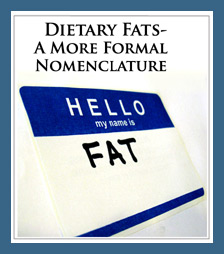Fatty Acid Nomenclature

Fatty Acid Nomenclature
E.Roehm, M.D. 2018
A fat is the product of fatty acids bonded to a backbone structure, which is often a glycerol which consists of a 3 carbon chain.
A triglyceride is specific type of fat formed by the combination of 3 fatty acids with a glycerol backbone.
Triglycerides are a major constituent of vegetable oils as well as fats in the body. A single food is usually a source of multiple different fatty acids.
The nomenclature of fatty acids is confusing with many different names being used for the identical substance.
A fatty acid is unsaturated if there is at least one double bond between the carbon atoms in the fatty acid. A fatty acid with only one double bond is called a monounsaturated fatty acid. A fatty acid with two or more double bonds is called a polyunsaturated fatty acid. A fatty acid with no double bonds between the carbon atoms in the main carbon chain of the fatty acid is called saturated fatty acid.
The term “omega” refers to the position of double bond in relation to methyl group on the end of the fatty acid.
As an example, omega-3 (ω-3) fatty acids have the last double bond 3 carbons from the terminal methyl group.
The term “n” can be used in an identical fashion.
Hence, omega-3 fatty acid, ω-3 fatty acid, and n-3 fatty acid are equivalent terms.
Polyunsaturated fatty acids:
1. Fish omega-3 (marine derived omega-3) fatty acids: These are initially created by marine single cellular organisms and incorporated into fish as they pass up the food chain.
Other names for fish omega 3 fatty acids:
long chain omega-3 fatty acids
long chain n-3 fatty acids
long chain ω-3 polyunsaturated fatty acids
long chain omega-3 polyunsaturated fatty acids
long chain n-3 polyunsaturated fatty acids
fish omega-3 fatty acids
Specific fish omega-3 fatty acids include:
Eicosapentaenoic acid (EPA)
Docosahexanaeoic acid (DHA)
2. Plant derived omega-3 fatty acids (alpha-linolenic acid) are essential fatty acids meaning the human body can’t manufacture it. Sources include walnuts and flax seeds. Very limited quantities of this type of fatty acid can be converted by the liver to EPA & DHA.
Other terms for plant derived omega-3 fatty acids (alpha-linolenic acid):
General:
Shorter chain omega-3 polyunsaturated fatty acid
Shorter chain n-3 polyunsaturated fatty acid
Specific:
alpha-linolenic acid (ALA)
α-linolenic acid
18:3 (n-3)
3. Linoleic acid is another essential fatty acid. Corn oil is an example of a food source of linoleic acid. (The amount of linoleic acid in corn oil is somewhat variable between samples, but is approximately 58% of the oil.)
Other terms:
General:
n-6 fatty acids
omega-6 fatty acids
Specific:
linoleic acid (LA)
18:2 (n-6)
———————————-
Monounsaurated fatty acids have only one double carbon bond in the fatty acid.
A specific monounsaturated fatty acid is oleic acid. Olive oil is a food source of oleic acid.
Oleic acid, other names:
General:
Monounsaturated fatty acid
n-9 fatty acid
omega-9 fatty acid
Specific:
18:1 (n-9)
———————————-
Saturated fatty acids have no double bonds between the individual carbon atoms of the fatty acid chain. Butter fat contains significant quantities of saturated fatty acids.
—————————–
Trans fatty acids are unsaturated fatty acids with the unsaturated bond between the carbon atoms of the fatty acid arranged in a trans configuration instead of the more common cis configuration. Most of the trans fatty acids that are in the food supply are introduced during the manufacturing process. Since mandatory labeling has been started in the United States, the amount of trans fatty acids that are in the food supply has thankfully dramatically decreased.
References:
- Jeremy M. Berg, John L. Tymoczko, Lubert Stryer. Biochemistry. W. H. Freeman; Seventh Edition edition. 2010.
- Harris WS. Fish oil supplementation: evidence for health benefits. Cleve Clin J Med 2004;71:208-221.
NutritionHeart.com E. Roehm, M.D. 2018
